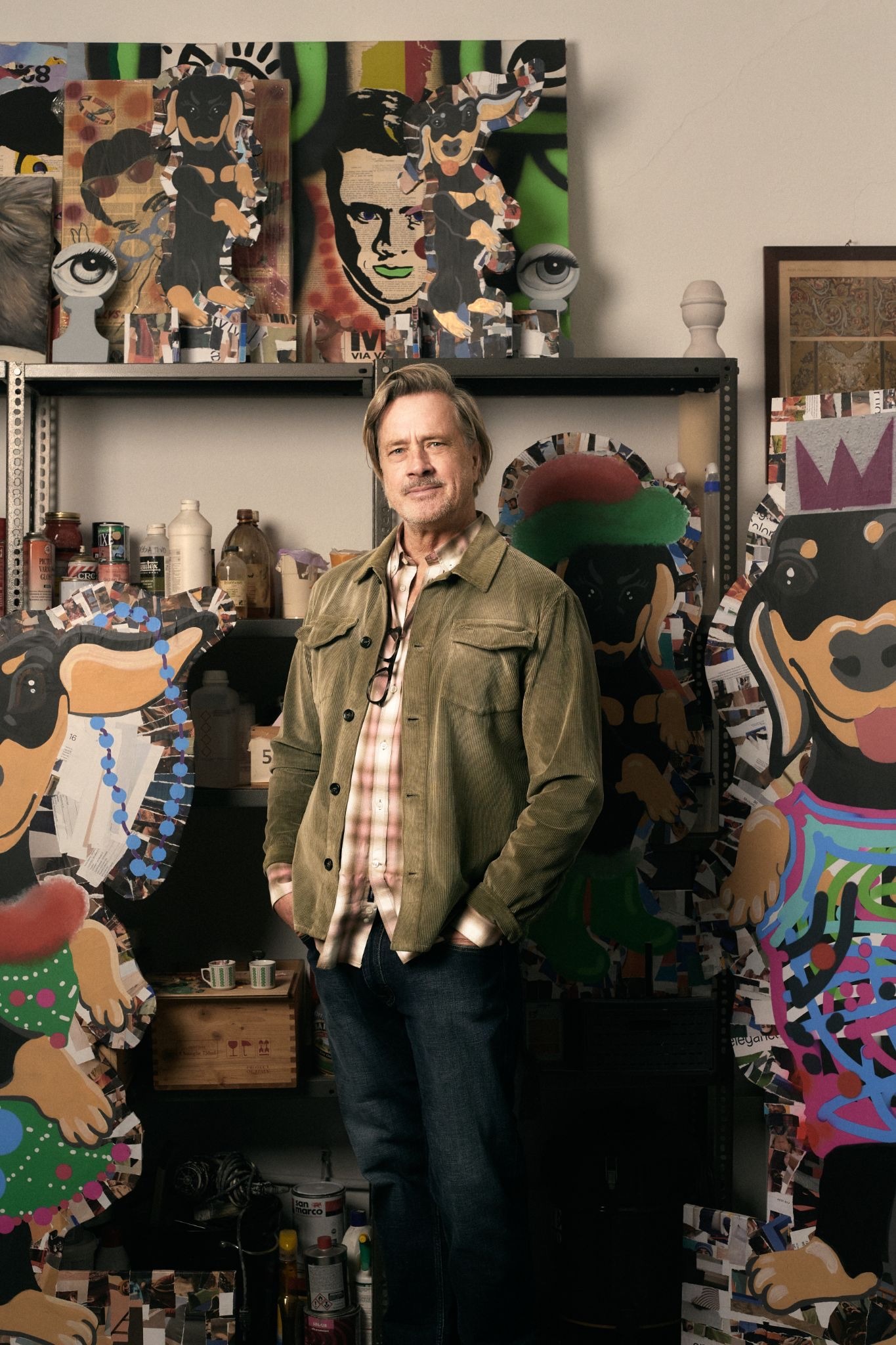

Ruth Asawa, _Untitled_ (FF.054, Albert and Child Sleeping), c. 1964. Private Collection © 2021 Ruth Asawa Lanier, Inc. / Artists Rights Society (ARS), New York. Courtesy David Zwirner.
The late Ruth Asawa’s iconic looped sculptures will be on display in [_Ruth Asawa: All Is Possible_](https://www.davidzwirner.com/exhibitions/2021/ruth-asawa-all-is-possible) until December 2021 at [David Zwirner](https://www.davidzwirner.com) in New York, curated by Helen Molesworth. The exhibition will show Asawa’s sculptures and lesser-known drawings and demonstrates how avant-garde art desires to place life and art in a dynamic conversation.
Asawa is best known for her intricate and meticulous wire sculptures, which she began sculpting in the 1940s, demonstrating a lightness even in the wire material. She also produced numerous drawings and prints build on simple gestures that transform into complex compositions.
Her other drawings, about the minutiae of everyday life—like sleeping children, garden plants and wicker chairs—allow the viewer to see into her home life. Placed next to the elaborate wire sculptures, the exhibition illuminates her devotion to creative pursuits and the unique way she saw the world.
_Flaunt_ sat down with Senior Director Jonathan Laib to learn more about the exhibition.


Ruth Asawa, _Untitled_ (S.266, Hanging Seven-Lobed, Multilayered Interlocking Continuous Form within a Form), 1961 © 2021 Ruth Asawa Lanier, Inc. / Artists Rights Society (ARS), New York. Courtesy David Zwirner.
**The show aims to provide a more comprehensive look at Asawa’s extensive work. How would you say it situates her lesser-known pieces in the context of those highly acclaimed?**
Ruth Asawa made incredible drawings and lived a very rich life. Her art and life merged in ways that need to be known and investigated further—there is still so much to discover. We definitely have an interest in promoting all aspects of Asawa’s life and vision through the exhibitions we assemble. Community was at the heart of everything for Asawa, and revealing those truths is the long-term objective. Helen Molesworth has opened our eyes to new ways of seeing Asawa and to new arguments for her to be considered among the most important artists of the twentieth century.


Ruth Asawa, _Untitled_ (MI.123, Rocking Chair), c. 1968 Private Collection © 2021 Ruth Asawa Lanier, Inc. / Artists Rights Society (ARS), New York. Courtesy David Zwirner.
**How is this representation of Asawa different from previous exhibitions of her work? How would you describe it?**
My hope is that our presentation and future museum and gallery exhibitions help to expand and narrow in on the various topics that concerned Asawa. The life she lived is so very different from that of the artists whom we all know from a male-dominated American art history that has overshadowed the conversation. Her experience does not fit the definition of success that we were taught to recognize; yet over time, I have come to realize that her life is the very definition of success. We have to relearn how to spot an authentic voice and how to reframe the idea of success based on the artist’s own terms.
**Asawa’s lesser-known drawings that spotlight the details of mundane, everyday life, such as sleeping children and garden plants, are also featured. Do you have a favorite lesser-known piece of work and why?**
Asawa did not take for granted the bits of time between mundane obligations. She also saw the value of the everyday. The object of her gaze, the material she worked with, these were not special things—but because she focused so fully on these things she was able to make something extraordinary from the ordinary. Her drawing of simple bentwood chairs, _Untitled_ (MI.153, Seven Thonet Style Bentwood Chairs), is a favorite. She uses the form of the chairs within her home as an armature for her obsession with mark making and love of creating balanced compositions that show an equal understanding of negative and positive space. This drawing is not precious; it is the record of an artist working out visual tensions in her natural creative flow. For me, she reaches that plane of abstraction that is typically only possible through musical compositions.


Ruth Asawa, _Untitled_ (S.052, Hanging Tied-Wire, Double-Sided, Center-Tied, Multi-Branched Form Based on Nature), 1965 © 2021 Ruth Asawa Lanier, Inc. / Artists Rights Society (ARS), New York. Courtesy David Zwirner.
**How would you define the significance of Asawa’s work, both as an artist and arts activist?**
People are still learning of Asawa, so her significance is still known only by those who have been paying attention over the past decade plus; or those who grew up around her and knew directly just how significant she was to the fabric of society. That significance is something that curators will be working hard to share with the world because there is so much to teach and so much to love. Those that connect to her work and dig deeper find more than a new favorite artist; they find a mentor and a life coach. Her work positively affects anyone willing to look and listen. She knew the power of the artist, she knew that only an artist can teach art. So many children in the San Francisco Bay Area have been directly affected by her efforts to get artists into the schools—I imagine this to be the part of her legacy that she was most proud of.
**How do you think Asawa’s work hopes to frame the way we see the world around us? Do you believe that this show is successful in achieving that?**
Ruth Asawa knew the power of art. It transformed her life and she became its biggest champion. She cherished her relationship with making art and felt compelled to help others to find that creative spark within themselves.
Our exhibition will help to grow the narrative around Asawa but there is more work to be done.
There is so much more to explore, I feel we are still at the tip of the iceberg. Asawa is endlessly fascinating and I cannot wait to see what our colleagues in the museum world will develop and tour for wider audiences to see and discover. The Modern Art Oxford and Stavanger Museum will open their long-anticipated exhibitions next year; and afterward others will follow.


Ruth Asawa, _Untitled_ (FF.075, Paul in Blanketon Woven Pattern), 1959 © 2021 Ruth Asawa Lanier, Inc. / Artists Rights Society (ARS), New York. Courtesy David Zwirner.
 
Ruth Asawa, _Untitled_ (FF.054, Albert and Child Sleeping), c. 1964. Private Collection © 2021 Ruth Asawa Lanier, Inc. / Artists Rights Society (ARS), New York. Courtesy David Zwirner.
The late Ruth Asawa’s iconic looped sculptures will be on display in [_Ruth Asawa: All Is Possible_](https://www.davidzwirner.com/exhibitions/2021/ruth-asawa-all-is-possible) until December 2021 at [David Zwirner](https://www.davidzwirner.com) in New York, curated by Helen Molesworth. The exhibition will show Asawa’s sculptures and lesser-known drawings and demonstrates how avant-garde art desires to place life and art in a dynamic conversation.
Asawa is best known for her intricate and meticulous wire sculptures, which she began sculpting in the 1940s, demonstrating a lightness even in the wire material. She also produced numerous drawings and prints build on simple gestures that transform into complex compositions.
Her other drawings, about the minutiae of everyday life—like sleeping children, garden plants and wicker chairs—allow the viewer to see into her home life. Placed next to the elaborate wire sculptures, the exhibition illuminates her devotion to creative pursuits and the unique way she saw the world.
_Flaunt_ sat down with Senior Director Jonathan Laib to learn more about the exhibition.

Ruth Asawa, _Untitled_ (FF.054, Albert and Child Sleeping), c. 1964. Private Collection © 2021 Ruth Asawa Lanier, Inc. / Artists Rights Society (ARS), New York. Courtesy David Zwirner.
The late Ruth Asawa’s iconic looped sculptures will be on display in [_Ruth Asawa: All Is Possible_](https://www.davidzwirner.com/exhibitions/2021/ruth-asawa-all-is-possible) until December 2021 at [David Zwirner](https://www.davidzwirner.com) in New York, curated by Helen Molesworth. The exhibition will show Asawa’s sculptures and lesser-known drawings and demonstrates how avant-garde art desires to place life and art in a dynamic conversation.
Asawa is best known for her intricate and meticulous wire sculptures, which she began sculpting in the 1940s, demonstrating a lightness even in the wire material. She also produced numerous drawings and prints build on simple gestures that transform into complex compositions.
Her other drawings, about the minutiae of everyday life—like sleeping children, garden plants and wicker chairs—allow the viewer to see into her home life. Placed next to the elaborate wire sculptures, the exhibition illuminates her devotion to creative pursuits and the unique way she saw the world.
_Flaunt_ sat down with Senior Director Jonathan Laib to learn more about the exhibition.
 
Ruth Asawa, _Untitled_ (S.266, Hanging Seven-Lobed, Multilayered Interlocking Continuous Form within a Form), 1961 © 2021 Ruth Asawa Lanier, Inc. / Artists Rights Society (ARS), New York. Courtesy David Zwirner.
**The show aims to provide a more comprehensive look at Asawa’s extensive work. How would you say it situates her lesser-known pieces in the context of those highly acclaimed?**
Ruth Asawa made incredible drawings and lived a very rich life. Her art and life merged in ways that need to be known and investigated further—there is still so much to discover. We definitely have an interest in promoting all aspects of Asawa’s life and vision through the exhibitions we assemble. Community was at the heart of everything for Asawa, and revealing those truths is the long-term objective. Helen Molesworth has opened our eyes to new ways of seeing Asawa and to new arguments for her to be considered among the most important artists of the twentieth century.

Ruth Asawa, _Untitled_ (S.266, Hanging Seven-Lobed, Multilayered Interlocking Continuous Form within a Form), 1961 © 2021 Ruth Asawa Lanier, Inc. / Artists Rights Society (ARS), New York. Courtesy David Zwirner.
**The show aims to provide a more comprehensive look at Asawa’s extensive work. How would you say it situates her lesser-known pieces in the context of those highly acclaimed?**
Ruth Asawa made incredible drawings and lived a very rich life. Her art and life merged in ways that need to be known and investigated further—there is still so much to discover. We definitely have an interest in promoting all aspects of Asawa’s life and vision through the exhibitions we assemble. Community was at the heart of everything for Asawa, and revealing those truths is the long-term objective. Helen Molesworth has opened our eyes to new ways of seeing Asawa and to new arguments for her to be considered among the most important artists of the twentieth century.
 
Ruth Asawa, _Untitled_ (MI.123, Rocking Chair), c. 1968 Private Collection © 2021 Ruth Asawa Lanier, Inc. / Artists Rights Society (ARS), New York. Courtesy David Zwirner.
**How is this representation of Asawa different from previous exhibitions of her work? How would you describe it?**
My hope is that our presentation and future museum and gallery exhibitions help to expand and narrow in on the various topics that concerned Asawa. The life she lived is so very different from that of the artists whom we all know from a male-dominated American art history that has overshadowed the conversation. Her experience does not fit the definition of success that we were taught to recognize; yet over time, I have come to realize that her life is the very definition of success. We have to relearn how to spot an authentic voice and how to reframe the idea of success based on the artist’s own terms.
**Asawa’s lesser-known drawings that spotlight the details of mundane, everyday life, such as sleeping children and garden plants, are also featured. Do you have a favorite lesser-known piece of work and why?**
Asawa did not take for granted the bits of time between mundane obligations. She also saw the value of the everyday. The object of her gaze, the material she worked with, these were not special things—but because she focused so fully on these things she was able to make something extraordinary from the ordinary. Her drawing of simple bentwood chairs, _Untitled_ (MI.153, Seven Thonet Style Bentwood Chairs), is a favorite. She uses the form of the chairs within her home as an armature for her obsession with mark making and love of creating balanced compositions that show an equal understanding of negative and positive space. This drawing is not precious; it is the record of an artist working out visual tensions in her natural creative flow. For me, she reaches that plane of abstraction that is typically only possible through musical compositions.

Ruth Asawa, _Untitled_ (MI.123, Rocking Chair), c. 1968 Private Collection © 2021 Ruth Asawa Lanier, Inc. / Artists Rights Society (ARS), New York. Courtesy David Zwirner.
**How is this representation of Asawa different from previous exhibitions of her work? How would you describe it?**
My hope is that our presentation and future museum and gallery exhibitions help to expand and narrow in on the various topics that concerned Asawa. The life she lived is so very different from that of the artists whom we all know from a male-dominated American art history that has overshadowed the conversation. Her experience does not fit the definition of success that we were taught to recognize; yet over time, I have come to realize that her life is the very definition of success. We have to relearn how to spot an authentic voice and how to reframe the idea of success based on the artist’s own terms.
**Asawa’s lesser-known drawings that spotlight the details of mundane, everyday life, such as sleeping children and garden plants, are also featured. Do you have a favorite lesser-known piece of work and why?**
Asawa did not take for granted the bits of time between mundane obligations. She also saw the value of the everyday. The object of her gaze, the material she worked with, these were not special things—but because she focused so fully on these things she was able to make something extraordinary from the ordinary. Her drawing of simple bentwood chairs, _Untitled_ (MI.153, Seven Thonet Style Bentwood Chairs), is a favorite. She uses the form of the chairs within her home as an armature for her obsession with mark making and love of creating balanced compositions that show an equal understanding of negative and positive space. This drawing is not precious; it is the record of an artist working out visual tensions in her natural creative flow. For me, she reaches that plane of abstraction that is typically only possible through musical compositions.
 
Ruth Asawa, _Untitled_ (S.052, Hanging Tied-Wire, Double-Sided, Center-Tied, Multi-Branched Form Based on Nature), 1965 © 2021 Ruth Asawa Lanier, Inc. / Artists Rights Society (ARS), New York. Courtesy David Zwirner.
**How would you define the significance of Asawa’s work, both as an artist and arts activist?**
People are still learning of Asawa, so her significance is still known only by those who have been paying attention over the past decade plus; or those who grew up around her and knew directly just how significant she was to the fabric of society. That significance is something that curators will be working hard to share with the world because there is so much to teach and so much to love. Those that connect to her work and dig deeper find more than a new favorite artist; they find a mentor and a life coach. Her work positively affects anyone willing to look and listen. She knew the power of the artist, she knew that only an artist can teach art. So many children in the San Francisco Bay Area have been directly affected by her efforts to get artists into the schools—I imagine this to be the part of her legacy that she was most proud of.
**How do you think Asawa’s work hopes to frame the way we see the world around us? Do you believe that this show is successful in achieving that?**
Ruth Asawa knew the power of art. It transformed her life and she became its biggest champion. She cherished her relationship with making art and felt compelled to help others to find that creative spark within themselves.
Our exhibition will help to grow the narrative around Asawa but there is more work to be done.
There is so much more to explore, I feel we are still at the tip of the iceberg. Asawa is endlessly fascinating and I cannot wait to see what our colleagues in the museum world will develop and tour for wider audiences to see and discover. The Modern Art Oxford and Stavanger Museum will open their long-anticipated exhibitions next year; and afterward others will follow.

Ruth Asawa, _Untitled_ (S.052, Hanging Tied-Wire, Double-Sided, Center-Tied, Multi-Branched Form Based on Nature), 1965 © 2021 Ruth Asawa Lanier, Inc. / Artists Rights Society (ARS), New York. Courtesy David Zwirner.
**How would you define the significance of Asawa’s work, both as an artist and arts activist?**
People are still learning of Asawa, so her significance is still known only by those who have been paying attention over the past decade plus; or those who grew up around her and knew directly just how significant she was to the fabric of society. That significance is something that curators will be working hard to share with the world because there is so much to teach and so much to love. Those that connect to her work and dig deeper find more than a new favorite artist; they find a mentor and a life coach. Her work positively affects anyone willing to look and listen. She knew the power of the artist, she knew that only an artist can teach art. So many children in the San Francisco Bay Area have been directly affected by her efforts to get artists into the schools—I imagine this to be the part of her legacy that she was most proud of.
**How do you think Asawa’s work hopes to frame the way we see the world around us? Do you believe that this show is successful in achieving that?**
Ruth Asawa knew the power of art. It transformed her life and she became its biggest champion. She cherished her relationship with making art and felt compelled to help others to find that creative spark within themselves.
Our exhibition will help to grow the narrative around Asawa but there is more work to be done.
There is so much more to explore, I feel we are still at the tip of the iceberg. Asawa is endlessly fascinating and I cannot wait to see what our colleagues in the museum world will develop and tour for wider audiences to see and discover. The Modern Art Oxford and Stavanger Museum will open their long-anticipated exhibitions next year; and afterward others will follow.
 
Ruth Asawa, _Untitled_ (FF.075, Paul in Blanketon Woven Pattern), 1959 © 2021 Ruth Asawa Lanier, Inc. / Artists Rights Society (ARS), New York. Courtesy David Zwirner.

Ruth Asawa, _Untitled_ (FF.075, Paul in Blanketon Woven Pattern), 1959 © 2021 Ruth Asawa Lanier, Inc. / Artists Rights Society (ARS), New York. Courtesy David Zwirner.









.JPG)
.jpg)







